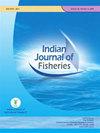Effect of replacement of dietary fish meal with silkworm pupae meal and black soldier fly larvae meal as a combination diet on the growth and digestive performance of koi carp Cyprinus carpio var. koi in the nursery phase
IF 0.3
4区 农林科学
Q4 FISHERIES
引用次数: 0
Abstract
The feasibility of using silkworm pupae meal and black soldier fly larvae meal in combination to replace fish meal inkoi carp fry was assessed. Two weeks-old koi fry (2.47±0.15 cm, 0.28±0.06 g) were used as experimental animals. Fouriso-nitrogenous experimental diets (T1, T2, T3, T4) with 35±0.37% crude protein were formulated. In T1, T2 and T3,50% of fish meal was replaced with silkworm pupae meal and black soldier fly larvae meal at different combinations, i.e.,T1 (25:75), T2 (50:50), T3 (75:25). In T4, 100% of fish meal was replaced with silkworm pupae meal and black soldier flylarvae meal at 50:50 ratio. Present research findings showed that T2 diet-fed fishes performed significantly better (p<0.05)than other diets in all the growth parameters viz., mean length gain (3.13±0.01 cm), mean weight gain (3.13±0.02 g),percentage length gain (127±0.71%), percentage weight gain (1118±7.07%), specific growth rate (4.16±0.01%/day),feed conversion ratio (1.30±0.01), feed efficiency ratio (0.76±0.01), protein efficiency ratio (2.18±0.01) and survival rate(28±1.41%). Digestive enzyme activities were also higher in T2 diet-fed fishes. Therefore, insect meal can be effectivelyutilised to replace fish meal in the diet of koi fry. Keywords: Black soldier fly larvae meal, Digestive enzymes, Growth performance, Koi carp fry, Silkworm pupae meal蚕蛹粉和黑蝇幼虫粉替代鱼粉对鲤鱼育婴期生长和消化性能的影响
评价了蚕蛹粉和黑虻幼虫粉组合替代鱼粉鲤鱼鱼苗的可行性。以2周龄的锦鲤鱼苗(2.47±0.15 cm, 0.28±0.06 g)为实验动物。配制粗蛋白质含量为35±0.37%的四氮试验饲粮(T1、T2、T3、T4)。在T1、T2和T3阶段,将50%的鱼粉替换为蚕蛹粉和黑虻幼虫粉,并以不同的组合,即T1(25:75)、T2(50:50)、T3(75:25)。T4期以蚕蛹粉和黑兵蝇粉50:50的比例代替100%的鱼粉。本研究结果表明,T2饲粮在平均增长(3.13±0.01 cm)、平均增重(3.13±0.02 g)、增长百分比(127±0.71%)、增重百分比(1118±7.07%)、特定生长率(4.16±0.01%/d)、饲料系数(1.30±0.01)、饲料效率(0.76±0.01)、蛋白质效率(2.18±0.01)和成活率(28±1.41%)方面均显著优于其他饲粮(p<0.05)。T2日粮鱼的消化酶活性也较高。因此,可以有效地利用昆虫粉替代鱼粉在锦鲤鱼苗饲料中。关键词:黑虻幼虫粉,消化酶,生长性能,锦鲤苗,蚕蛹粉
本文章由计算机程序翻译,如有差异,请以英文原文为准。
求助全文
约1分钟内获得全文
求助全文
来源期刊

Indian Journal of Fisheries
FISHERIES-
CiteScore
0.90
自引率
20.00%
发文量
0
审稿时长
6-12 weeks
期刊介绍:
Indian Journal of Fisheries is published quarterly by the Indian Council of Agricultural Research (ICAR), New Delhi. Original contributions in the field of Fish and fisheries science are considered for publication in the Journal. The material submitted must be unpublished and not under consideration for publication elsewhere.
Papers based on research which kills or damages any species, regarded as thratened/ endangered by IUCN crieteria or is as such listed in the Red Data Book appropriate to the geographic area concerned, will not be accepted by the Journal, unless the work has clear conservation objectives.
 求助内容:
求助内容: 应助结果提醒方式:
应助结果提醒方式:


